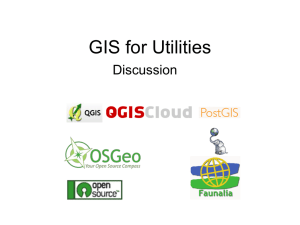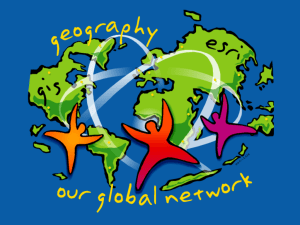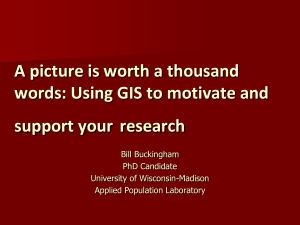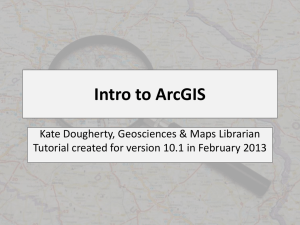Exploring GIS Software
advertisement
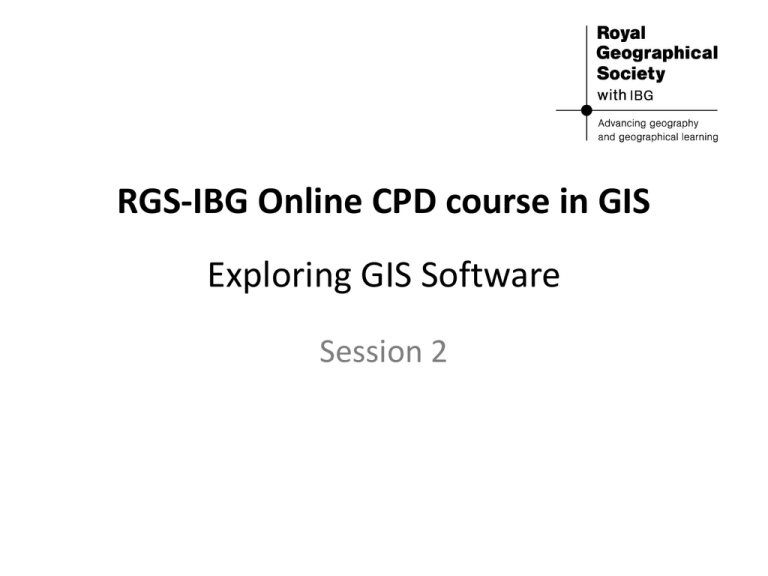
RGS-IBG Online CPD course in GIS Exploring GIS Software Session 2 There are many Geographical Information Systems (GIS) available today. They range from high-powered analytical software such as ArcGIS to visual web applications such as the Office of National Statistic’s Neighbourhood Statistics Neighbourhood maps and the London Profiler. Different GIS systems can be used for different purposes. Due to the vast number of GIS available it is simply not possible to provide training for each in this course. However do not worry, they all have a number of features in common. Understanding these basic features will give you confidence with any GIS system that you use. What are the features of GIS software? First of all there is the interface, this is what you see and interact with when the software opens. The interface can be broken down into four basic features; • Map • Layers • Navigation • Functions Both the Map and the Layers are features of the data being used in the software. Navigation and Functions are features of the software, it is the latter which often differentiates different GIS systems. The map is much like a paper map but on your computer screen. The difference is, with a GIS you are able to integrate lots of paper maps on top of one another, this is what we call the layers. Layers often represent different types of maps, for example topographical maps, thematic maps and point maps. Using the GIS layer controls you are able to view different maps at the same time by overlaying them or concentrate on just a single layer depending on your needs. Unlike a paper map the map in a GIS is not static, you are able to navigate around it and zoom in and out of it. Finally the functions, these are the tools which allow you to do different things with the data in your map. The array of functions available varies even more widely than the number of GIS systems available, one GIS system does not contain them all. Functions can range from making layers more transparent, to measuring distances and areas, to viewing your data threedimensionally to complex statistics. Exercise With the four basic features of a GIS in mind watch the following three videos. They show the interfaces of three GIS systems. However, what they really show is just how similar each application is with the ability to change the map by turning layers on and off and moving around the map. The function buttons are highlighted in the video but are not explored at this point. 1. ArcMap ESRI’s ArcGIS is one of many geographical information systems (GIS), or GIS software. A GIS allows you to interactively work with spatial data. ArcGIS is what ESRI refer to as a suite of products which can be tailored to your need. The basic version of ArcGIS is what we will be using in this course and is all the majority of GIS users will ever need, it is composed of three essential products; ArcMap, ArcCatalog and ArcToolBox. ArcMap is what what you will use here, it is where you can see and interact with your map data. ArcCatalog allows you to organise your geographical data (much like Windows Explorer) and ArcToolBox holds some of the more advanced geoprocessing tools (or advanced functions). 2. Google Earth Google Earth is a popular geobrowser that provides an exploratory interface to a rich series of spatial data sets. Some of these may be considered 'formal' - as they are collected centrally and distributed in a top-down manner. Examples include the high resolution air photography and the terrain, road and government layers. Others are less formally produced in a 'bottom up' manner as individuals across the World contribute information to what may be considered the 'Geographic Web' through sites such as Wikipedia and Panaramio. Both the kinds of data and content of individual data sets provided through Google Earth changes with some frequency. 3. WebGIS - London Profiler WebGIS are applications found on the internet. Because of this they do not let you add your own data and their functionality is often very minimal. However they provide excellent tools for visualising particular datasets or areas. There are many examples of these on the web including Neighbourhood Statistics, Streetmap, OpenMapSource and the London Profiler to name but a few. Summary You should now know; • There are many GIS software systems available. • The part of the GIS you interact with is called the Interface. • Within the interface you will find a map and layers (which are dependent upon data) as well as navigation tools and functions. • All GIS have these features in some form.



